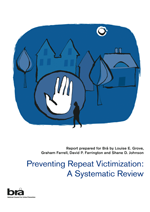- Start
- / Home
- / Publications

Preventing Repeat Victimization
A large proportion of all crimes are committed against crime victims who have been victimized before, a phenomenon known as repeat victimization. There is thus a potential to achieve substantial benefits by focusing crime prevention measures on individuals, institutions or objects that have previously been exposed to crime. Successful strategies of this kind would prevent repeat victimization, and thus also would prevent a substantial proportion of all the crimes committed.
The crime prevention measures that are implemented to this end may take several different forms. The strategy is not primarily about specific kinds of measures, but rather involves a way of directing crime prevention measures at relevant targets. An increasing number of crime prevention initiatives have been directed at repeat victimization especially to prevent repeat burglaries. But how well do they work? What does the research tell us?
There are never sufficient resources to conduct rigorous evaluations of all the crime prevention initiatives employed in an individual country such as Sweden. For this reason, the Swedish National Council for Crime Prevention (Brå) has commissioned distinguished researchers to conduct a series of international reviews of the research published across a range of fields. This report presents a systematic review, including a statistical meta-analysis, of the effects of initiatives to prevent repeat victimization. The work has been conducted by Lecturer Louise E. Grove of Loughborough University (UK), Senior Research Fellow Graham Farrell of Simon Fraser University (Canada), Professor David P. Farrington of Cambridge University (UK), and Professor Shane D. Johnson of University College London (UK).
The study follows the rigorous methodological requirements of a systematic review. The analysis combines the results from a number of evaluations that are considered to satisfy a list of empirical criteria for measuring effects as reliably as possible. The meta-analysis then uses the results from these previous evaluations to calculate and produce an overview of the effects associated with initiatives to prevent repeat victimization.
The systematic review and the statistical meta-analysis presented in this report are based on a substantial number of empirical evaluations. Even though important questions remain unanswered, the study provides an accessible and far-reaching overview of the effects of initiatives to prevent repeat victimization. Generally, the results are encouraging; suggesting that appropriately targeted situational prevention measures can significantly reduce repeat burglaries.
About the publication
© The Swedish National Council for Crime Prevention, 2012
Authors: Louise E. Grove, Graham Farrell, David P. Farrington and Shane D. Johnson
urn:nbn:se:bra-472

